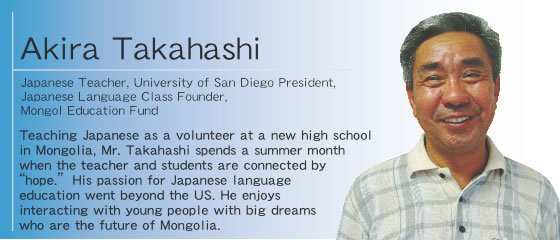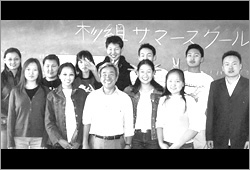YuYu interview Akira Takahashi
 |
| —— Can you tell us about your volunteer activities in Mongolia? I currently teach Japanese at the University of San Diego (USD) as well as in classes that I offer on my own. In addition, using my 1-month vacation in August, I go to Mongolia and teach Japanese at a senior high school on a voluntary basis. The school is called Shine Mongol High School and located in Ulan Bator, the capital of the country. It is the only private high school in Mongolia and was founded by Mr. Janchiv Galbadrakh, who studied education in graduate school at Tohoku University. Envisioning a high school that employs the Japanese education system to help create efficient professionals for Mongolia's future, he founded Shine Mongol in October 2000. This school was founded with support from the Japanese people, especially those from Yamagata Prefecture. So, things from Japan are used all over the school. For example, the school uniforms are recycled from high schools in Yamagata. Also, the desks, chairs and blackboards are all from Japan. While senior high schools in Mongolia usually have a 2-year curriculum, Shine Mongol has a 3-year curriculum (grades 10 to 12), just like Japanese high schools. This allows the students to enhance their academic abilities and prepare themselves to study abroad. Yet, the annual tuition of $400 per student is too much for most people in Mongolia where the average monthly income is around $80. As a result, not many 11th graders advance to the 12th grade. I didn't want to waste the students' desire to learn, so last year I volunteered to teach at there. Also, I set up the Mongol Education Fund this year, hoping to give as many students as possible the opportunity to study. 
At La Jolla High School, 1991. This picture was a Christmas gift from his students.
Two years ago, in summer, I visited China with my daughter. There, we met two Australian women who were elementary school teachers. They came to China to teach English on their summer vacation. A light bulb went on in my head. Actually, since my youth I'd had a dream of helping people somewhere in Asia. That was why I'd chosen to become a Japanese teacher. Yet, since 1978, the year when I settled in America, I'd been busy with everyday life, which had caused me to lose the passion of my youth. Moreover, I thought it was impossible for me to pursue my dream by working alone outside of the US for a long period of time because I now had a wife and a daughter. But, I guess I still had hoped somewhere in my heart, thinking someday I will. Inspired by these Australian teachers, I concluded that I would be able to teach Japanese somewhere in Asia during the summer. So, as soon as I returned to San Diego, I started looking for regions in Asia where there were open positions for Japanese teachers. While I had several countries in mind, including China and Thailand, I learned that Mongolia had the highest percentage of the population that studied Japanese, which made me want to go there. 
A herd of cows and a yurt enjoying Mongolia, the prairie paradise, 2004.
activities? In Japan, there is a government agency that supports Japanese language education in Mongolia. I e-mailed the director of that agency, requesting information on schools that would accept a volunteer Japanese teacher during the summer. However, I received a reply shortly, which informed me that there were no such schools. Like in the US, people in Mongolia take summer vacations from mid-June through August. Essentially, Mongolians are nomadic, so they move and live in a different place for summer. Also, because they believe that it is most important for children to help their parents, they do so during their summer vacations; thus they don't have to study. For these reasons, the director turned down my request, adding, If you can take a long vacation any other time, please contact me again. It was impossible for me to take a long vacation during non-summer months, so I was desperate. I asked him again and again to find a school that would accept me. A month later, which was January in 2003, I was informed that Shine Mongol High School would hold the first summer school in Mongolia. So, I immediately requested the agency to introduce me to Mr. Galbadrakh, principal of the school. Then I contacted the principal and kept in touch with him. Things went well. However, as if it had been waiting for me, SARS started to spread in the north. It spread from Beijing through the Inner Mongolia Autonomous Region, and in early May, it finally reached Mongolia's capital, Ulan Bator. I honestly thought that was it. Because of this, quite a few people were against my plans to go to Mongolia. After that, SARS eased, so I went to Mongolia as I'd planned. When I was there, I learned that various measures had been taken to curb the spread of the disease: the temporary closure of public places, including schools; curfews; wearing masks when going outside, etc. —— What was your impression of Mongolia when you visited the country for the first time?  The Internet was the only source that I used to get information about Mongolia, so I was a little bit nervous before leaving the US. Prairies and nomads, these were the only images of the country that I had. Actually, after I got there, I soon became used to life there, partly because of the facial similarity between Mongolians and Japanese. Ulan Bator, where I stayed, was a bigger city than I'd expected. But, unlike Japan or the US, the concept of hygiene was yet to be developed in Mongolia; I was a bit surprised to see that people drank alcohol from one cup when welcoming a guest. Other than that, I didn't experience any major culture shock and was able to spend fulfilling days there. The Internet was the only source that I used to get information about Mongolia, so I was a little bit nervous before leaving the US. Prairies and nomads, these were the only images of the country that I had. Actually, after I got there, I soon became used to life there, partly because of the facial similarity between Mongolians and Japanese. Ulan Bator, where I stayed, was a bigger city than I'd expected. But, unlike Japan or the US, the concept of hygiene was yet to be developed in Mongolia; I was a bit surprised to see that people drank alcohol from one cup when welcoming a guest. Other than that, I didn't experience any major culture shock and was able to spend fulfilling days there.—— You’ve been interested in Asia since you were young. Why? Maybe because I was an only child, I wasnユt good at socializing with other people when I was little. I'd rather be alone, reading or playing in nature. On the other hand, I wanted to change myself and somehow became interested in adventures or expeditions. I was especially interested in the Silk Road people sought something in that western region, fascinated by the romance of travel just thinking about it made me excited. I probably started to be attracted by Asia around that time. The next thing I knew was that I was dreaming of traveling around in Asia. 
The many street vendors of Ulan Bator, 2004.
It was when I was 25 years old. I'd never traveled outside of Japan before, but I decided to go backpacking alone in Hong Kong, Myanmar, Bangladesh, India, etc. for half a year. When I left Japan, I had confidence that I would be able to find something that I could try. But I only discovered that I was overwhelmed by the harshness of reality. In those days, the war between Bangladesh and Pakistan had just ended, and it wasn't unusual that I would see people collapsing in front of me from malnutrition. And bullet holes were all over the buildings there. It was so graphic. On both sides of main streets, I would see people who had lost their limbs in the war crying and wailing. It was like hell. Also in India, I saw an incredible number of homeless people, from the very young to the old. As I continued such a horrendous journey, I came to realize that I could do nothing. "What can I do to help these people?" After I kept asking this question to myself, I finally found the answer education. I didn't think it was too late for me to become a teacher and believed that being a Japanese language teacher would suit me. So I checked out graduate programs inside and outside Japan and tried to find the right program for me. I finally decided on San Diego State University (SDSU). 
Happily wearing a traditional Mongolian costume, deel, 2004.
Right after graduating from SDSU, I started a Japanese language class in San Diego and at the same time I started teaching Japanese in college and high school in the city. When I had just become a teacher, everything was by trial and error. I didn't have time to think about what a good class ought to be; I just taught my class. So, I am sure that my class was boring. But, the more experienced I became, the more I understood that if my class didn't attract the students, I couldn't motivate them. To offer an attractive class, I must conduct class sessions by using a communication style that both my students and I could enjoy. Today, I enjoy teaching my classes, always exchanging smiles and jokes with my students. This is also the case in Mongolia. When students have difficulty understanding a word or a phrase, I use an innovative way to explain it, using gestures, etc. In this way, I use up all my energy during class, so after a 90-minute session, I am totally exhausted (laughter). —— What are the differences you feel when comparing students from Mongolia, America, and Japan? Most Mongolian high school students have big dreams. They seriously think about becoming president of the country, a politician, or a doctor to save their country. They have ambitions of studying at a university in Japan on a scholarship, if possible, and contributing to their country after graduation, using the knowledge and skills they've acquired. So they study very hard. They seriously think about the future of their country. How many high school students in the US or Japan are this way? Why are children living in the US or Japan, richer countries, not necessarily happy? Children in Mongolia have sparkling eyes. I cannot help thinking that there is something we can learn from these Mongolian children. Another difference that I feel is that family ties are very strong in Mongolia. When I ask children whom they admire, they answer immediately, "My parents who brought me into this world." or "My parents who work to support me." In addition, Mongolians help family members or relatives whenever it's necessary. Mongolia is by no means rich, but when I visit it reminds me of the good old days of Japan. —— You’ve become a link between America and Mongolia. How do you feel about it? I'd like to keep promoting the exchange between the USD and the Shine Mongol students. I've had students from each country write essays entitled "My Family" and exchange their essays with students from the other country. They seem interested in each other because they were learning the same foreign language, Japanese, although they live far away from each other. This exchange seems to motivate the students from both countries to work harder than ever to learn Japanese. Like this, I'd like to continue helping exchange programs between the two countries, in one way or another. 
「新モンゴル高校」のサマースクールで、毎年ボランティアとして日本語を教えている。
Always welcoming new challenges, I want to live my life. As we grow older, we get used to the comforts of a stable life and tend to be intimidated by new challenges. But, I can't help but feel that in doing so we waste our lives. I decided to go to Mongolia to challenge myself. Actually, when I visited China, I had a problem with the food and became sick. I didnt want to repeat the same problem, so since I decided to go to Mongolia, I've jogged and done a workout every day, building myself up both physically and mentally. Thanks to this, my stomach has become flat and my pants have become loose. When I played soccer with the high school students in Mongolia, they told me again and again that I was young! At the same time, I felt that I couldn't push myself too hard physically any more. Because I overdid it and the food didn't agree with me, I became a little bit sick. I'd like to continue visiting Mongolia and teaching Japanese at Shine Mongol High School. Last year, many parents wondered why their children would need to study in summer. As a result, only 30 students participated in summer school. Yet, out of the seven students who passed the exam for studying in Japan this year, six had participated in last year's summer school. This may show that both students and parents have become more positive about summer school. This year, to my surprise, about 100 students participated in the summer school. In this way, I'd like to keep visiting Mongolia and meeting as many young people as possible, 300, 400, and more.... I look forward to seeing my students grow up to become professionals in different fields and leaders of their country. Through Japanese language education in Mongolia, I feel that my students and I have been connected by the word "hope." In one of his works, Victor Hugo said, "There is one spectacle greater than the sea: That is the sky; there is one spectacle greater than the sky: That is the interior of the soul." I am sure we are just tiny beings in the universe, but inside each of us, we have unlimited potential. That's why we always have hope. One can only do certain things. That's why, as a Japanese teacher, I would like to be able to give young people as many dreams and hopes as possible. (11-16-2004 issue) |

